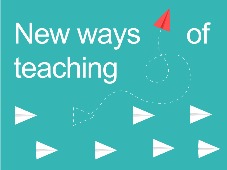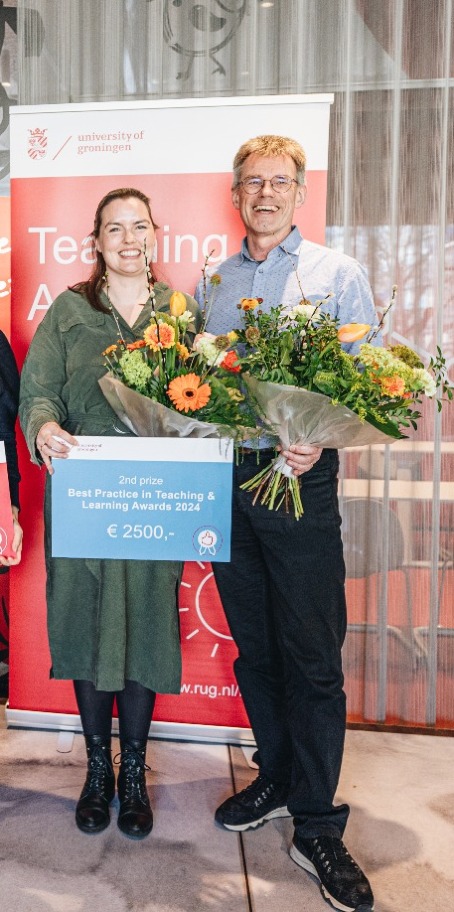Minder zenden en meer discussie in ‘Geographies of the United States’

In New Ways of Teaching vertellen docenten over hun innovatieve, creatieve en effectieve onderwijsinitiatieven. Van ongewone lesmethoden tot nieuwe technologieën—alles is mogelijk. Hoe ontstaan deze ideeën en welke impact hebben ze op studenten? Deze maand: Studenten nemen een sprong in het diepe bij Geographies of the US.

Begin dit jaar wonnen dr. Peter Groote en dr. Leonieke Bolderman, respectievelijk universitair hoofddocent en universitair docent culturele geografie, de tweede plaats in de Best Practice Award in Teaching & Learning vanwege hun innoverende vak ‘Geographies of the United States’. In dit vak krijgen studenten geen hoorcolleges, werkgroepen of standaard cursusliteratuur. In plaats van continu aandachtig te luisteren naar de docenten, doen de studenten juist een groot deel zelf.
‘Let the customer do the work’
In plaats van traditionele les en zelfstudie, doen de studenten interactieve opdrachten zoals de zogenaamde ‘Pecha Kucha-presentaties’, geannoteerde video's, onderzoeksprojecten en ontmoetingen met experts. Onze insteek is dat we minder informatie willen zenden en de studenten meer zelf willen laten ervaren en doen. We merken dat de opdrachten die we geven veel meer betrokkenheid creëren bij studenten dan bij traditionele zelfstudie. Dit geldt voor de betrokkenheid tussen studenten, maar ook met de docenten en het materiaal.
Visuele interactie
De studenten zijn vanaf het begin van de cursus veel meer zelf bezig dan bij een gemiddeld vak. In de tweede week van het vak geven ze bijvoorbeeld al presentaties in ‘Pecha Kucha’ formaat. Dit zijn slides die na een vaste tijd doorwisselen (in ons geval 30 seconden) en waar alleen maar visueel materiaal op mag staan, dus geen tekst en bullet points.
Vooraf aan de presentaties kijken de studenten video’s in plaats van dat ze boeken of artikelen moeten lezen. Deze staan in de Interactive Video-tool van Feedbackfruits, waarin studenten en docenten actief comments kunnen plaatsen en op elkaar kunnen reageren. We merken dat dit studenten veel meer engageert dan traditionele zelfstudie. De tussentoets die de studenten moeten doen is ook gebaseerd op deze video’s.
Minder stress, meer ongedwongenheid
Het meest geliefde onderdeel van ons vak zijn de drie of vier masterclasses die we ieder jaar aanbieden. Deze worden gegeven door gasten met veel ervaring met de Verenigde Staten (vanzelfsprekend meestal Amerikanen) over een onderwerp naar keuze. Dit zijn niet zo zeer colleges, maar meer interactieve sessies waarin studenten op een heel persoonlijke manier meekrijgen hoe het is om in de VS te wonen, te werken en daar naar een 'college' te gaan. Dit is geen onderdeel van de toetsing, waardoor ze minder stress hoeven te hebben over dingen die ze moeten onthouden en actiever deel kunnen nemen aan een gesprek of discussie met de gast. De studenten zijn over het algemeen ook tevreden over de toetsing omdat deze uit veel kleine elementen bestaat, waardoor er minder stress is dan bijvoorbeeld bij één eindtoets het geval zou zijn.
Uit nood geboren
Ooit kregen we de opdracht om het vak in erg korte tijd op te zetten, dit is ook de eerste aanleiding geweest voor het ontwerp. Het was tijdsgewijs niet mogelijk om allerlei hoorcolleges in elkaar te zetten. Eigenlijk is het unieke ontwerp van dit vak uit nood geboren, maar dat deed niet af aan de positieve ervaring die veel studenten hadden.
Nog belangrijker is dat we ervan overtuigd zijn dat het zenden van informatie bij een vak als dit niet werkt voor studenten. We vinden het belangrijk dat studenten zo actief mogelijk het onderwerp, in dit geval de Amerikaanse samenleving, moeten ervaren. Hierin zijn de interactieve masterclasses, video’s en het eigen onderzoek belangrijke onderdelen van. We merken dat studenten (min of meer noodgedwongen) een stuk actiever zijn vanaf het begin. Ze waarderen de vrijheid en de actieve rol die ze krijgen, ook al is dat vaak wel even wennen. Het belangrijkste voor ons als docenten is dat de retentie bij studenten veel hoger is. Ze blijven bepaalde elementen van het geleerde langer onthouden, in plaats van slechts tot en met het tentamen.
Twee vliegen in één klap
Niet alleen de studenten, maar ook wij als docenten leren ieder jaar opnieuw tijdens het vak. Er zijn elk jaar weer andere masterclasses, andere onderzoeksonderwerpen van studenten, en ook andere discussies over de video’s. Dit zorgt ervoor dat wij ook ieder jaar een interessante leerervaring hebben. Maar het grootste voordeel voor ons is dat we veel meer betrokken zijn bij het leerproces en de activiteiten van de studenten. Een nauwere band met studenten maakt het lesgeven veel persoonlijker en leuker.
Meer informatie
-
Lees de andere edities van New Ways of Teaching
